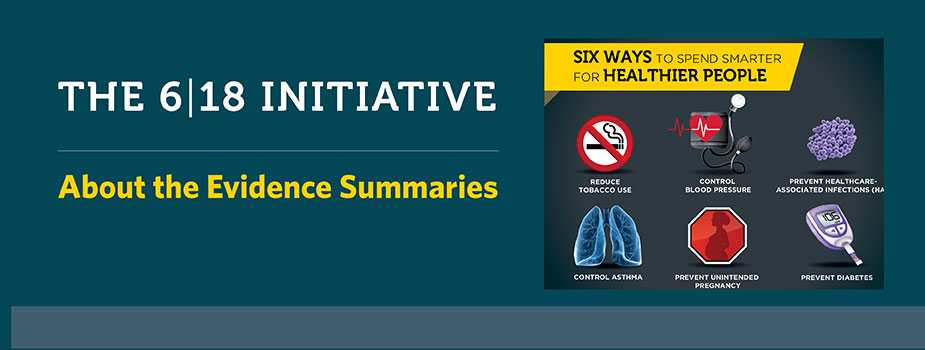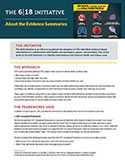About the Evidence Summaries

The Initiative
The 6|18 Initiative is an effort to accelerate the adoption of CDC-identified evidence-based interventions in collaboration with health care purchasers, payers, and providers. One of the goals of the 6|18 Initiative is to identify interventions that improve health and reduce costs.
The Approach
CDC’s policy specialists gathered CDC subject-matter experts to identify health conditions that:
- affect large numbers of people
- are associated with high health care costs
- have evidence-based interventions that may improve health and reduce health care costs
Additionally, we consulted experts in insurance, health care, and health administration about interventions for improving health and controlling costs. We also consulted them to clarify what kind of evidence payers consider when selecting new services.
These expert consultations, along with our own evidence review framework described below, resulted in a set of evidence summaries for each of the 6|18 health conditions. These evidence summaries identify the 6|18 interventions and are accompanied by studies that demonstrate opportunities to improve health and reduce health care costs.
The Frameworks Used
In addition to expert opinion, CDC consulted two frameworks to help develop the criteria for the evidence summaries.
1. CDC Conceptual Framework
We first reviewed the CDC Conceptual Framework as a resource to determine which levels of evidence to consider in our review. Based on feedback from health care payer experts that the “weak” level of evidence (field-based summaries, abstracts, projects without appropriate evaluation) may not be as relevant for decision making, we did not consider that category in our criteria. Additional feedback from the same experts persuaded us to adapt the CDC Conceptual Framework criteria for “moderate” level of evidence, and only included case studies labeled “large” (The original criteria included those labeled “no case size mentioned.”)
We also considered the following five topic areas from the CDC Conceptual Framework to structure our evidence review:
- Effectiveness (How well did the intervention achieve the desired outcome?)
- Reach (How well did the intervention reach the target group of people?)
- Feasibility (How well can the intervention be put into practice?)
- Sustainability (What will it take to maintain the intervention over time?)
- Transferability to other settings (What other settings have used the intervention successfully?)
2. The Policy Analytical Framework
We consulted the Policy Analytical Framework before developing evidence reviews since some of the proposed interventions might be used to inform policy recommendations for health care payers, purchasers, and providers. The Policy Analytical Framework provides a method to consider policies that can improve health. It also includes economic considerations. Health care subject-matter experts and payers told us economic analysis was important in their decision making. Based on their feedback, we selected three criteria from the Policy Analytical Framework’s policy analysis domain (Public Health Impact, Feasibility, Economic and Budgetary Impact) and modified two: the “Public Health Impact” and “Economic and Budgetary Impact.” We modified the framework to help us consider topics payers consider when they make coverage or practice decisions.
The 6|18 Evidence Summary Criteria
By consulting with internal and external experts and reviewing two CDC frameworks, we developed evidence inclusion criteria against which to review literature and studies for the 6|18 initiative. We gathered literature from CDC experts, literature from a thorough review of health and medical databases, as well as from sources such as The Guide to Community Preventive Services (the Community Guide), the United States Preventive Services Task Force, and the Agency for Healthcare Research and Quality. We drew from electronic databases containing:
- Reviews (summary recommendations based on systematic review or synthesis of current evidence from multiple studies and other evidence-based sources)
- Individual studies (scientific evaluation of an intervention in a single study)
To be included in the evidence summaries, an item had to meet at least one of the following levels of evidence. (Table modified from the CDC Conceptual Framework).
| Level of Evidence | Definitions and Examples |
|---|---|
| Moderate |
|
| Strong |
|
| Rigorous |
|
Literature materials that met one of the levels of evidence and that also could successfully answer the effectiveness, reach, feasibility, sustainability, and transferability criteria were considered stronger sources for inclusion.
For those evidence literature materials that contained policy and economic considerations, the following questions were asked (table modified from the CDC Policy Analytical Framework):
| Criteria | Example Review Questions |
|---|---|
| Public Health Impact | What population will benefit? How much? When? Are the populations in the study group similar to the payer’s target population? |
| Feasibility | What is the chance that decision makers can successfully implement the proposed policy? |
| Economic and Budgetary Impact | What are the budgetary costs and benefits associated with the policy? How do costs compare with benefits (e.g., cost-savings, costs averted, return on investments, cost-effectiveness, cost-benefit analysis)—especially in the short (1–3 year) term? Could the payer or purchaser’s employees or enrolled persons lose less time from work as a result of this intervention? |
This process resulted in a summary of evidence for the six conditions’ proposed interventions.
The Format
Each of the six health condition summaries contain one or more evidence-based interventions. These interventions are presented as opportunities for payers and providers to consider as proposed payer interventions. Each condition’s evidence summary includes the following information:
- Who is at risk (the epidemiology or health burden of the condition)
- Current status of payer coverage (as of August 2015)
- Opportunities for payers and providers
- Key health and cost evidence messages for payers and providers
- Supporting health and cost evidence: Science behind the issue
The Supporting health and cost evidence: Science behind the issue section is a summary of evidence materials presented in the order that the evidence materials align with the 6|18 evidence inclusion criteria. Summaries may include systematic reviews and individual health impact and cost impact references.
- Page last reviewed: November 17, 2015
- Page last updated: November 17, 2015
- Content source:


 ShareCompartir
ShareCompartir
